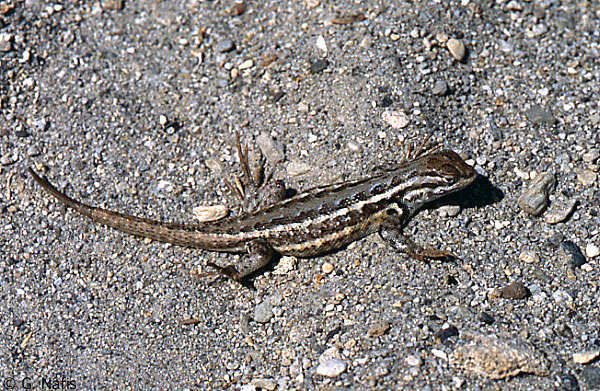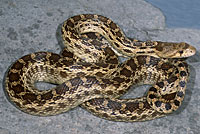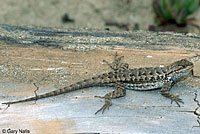
A Guide to the Amphibians
and Reptiles of California

Identifying California Reptiles and Amphibians
| Search for herps by region: |

| Snakes | Lizards | Turtles | Frogs | Salamanders |
 |
 |
 |
 |
 |
This section attempts to serve as a very simple visual guide to aid you in the identification of herps that you might encounter in California. Although this site was not originally intended to be an identification guide, most of the email I get asks me to identify an animal that a user saw or found in their house or yard. As we continue to build new houses in former open space that once served as reptile and amphibian habitat, these encounters will continue to increase. Since most of the requests I have received have come from the Bay Area, Coastal Southern California, and the area around Sacramento, where most of the population in the state resides, I have made illustrated lists of the herps in these regions in order to help you narrow down the species to consider in your identification process. I have also added a page for herps of the California Deserts. All of those regional pages can be found at the links to the left. This is not intended to be a comprehensive identification key, just a very basic guide for those who know little or nothing about reptiles and amphibians, who have had a good look at the size, shape, color, pattern, habitat, and behavior of an animal. Even if it does not help you make a positive identification, this guide should at least help steer you in the right direction. Please feel free to send me email with your questions if you can't find the answer to them here. How to identify an animal using this guide Determine if the animal you want to identify is a reptile or amphibian, then determine what type of reptile or amphibian you are attempting to identify - a snake, lizard, turtle, frog, or salamander, using the information and pictures below. If the animal has hair or feathers or lacks a backbone, then it is not a herp and you should look elsewhere. If the animal has smooth skin that looks wet, with no scales, then it is an Amphibian. If the amphibian has four legs and a tail, it is a salamander. if the amphibian has no tail, it is a frog. Toads are also amphibians - a type of frog - but their skin does not look wet. It is roughly textured, but there are no scales. Newts also have rough skin at times. They can be differentiated from lizards by their lack of scales. If the animal is not a fish and it has scales, then it is a Reptile. If the reptile has legs, but not a large shell on its back, it is a lizard. If there are legs and a large shell on the back, it is a turtle. If it has no legs and no shell, then it's a snake (or a legless lizard.) After you know the type of reptile or amphibian, click on the group name to view a page with pictures grouped by pattern or appearance or other characteristics. Read the brief descriptions and look for a picture of an animal that resembles yours, but beware that many types look similar. When you find the animal, click on the name to view more pictures, information, and a map showing where the animal occurs in California. The maps are general representations of where various animals occur in the state and they can quickly help you determine if an animal occurs in your area.
You may find identification of an animal difficult if it does not look exactly like those shown here, or if its behavior or surroundings do match our brief description. Keep in mind the following: If you are having difficulty using this guide to identify a California herp, it might help to consult a good field guide such as the Peterson Field Guide: Western Reptiles and Amphibians 3rd Edition, by Robert C. Stebbins, © 2003, or Stebbins, Robert C., McGinnis, Samuel M. Field Guide to Amphibians and Reptiles of California: Revised Edition (California Natural History Guides) University of California Press, 2012. For a list of more books and websites that can help you, check our resources page. Reptiles    Snakes have long bodies with no legs. They crawl on their bellies. Some are excellent climbers, most can swim. The body is covered with dry skin with visible scales, which may be smooth or rough, and might appear wet or slimy. Snakes can be found on land, in water, in trees and shrubs, underneath objects, and in holes in the ground. They can be active at any time during the day or night, but many species are mostly either diurnal or nocturnal. Snakes can be seen whenever there is warm weather. Rarely in winter. Click Here for more information about identifying California snakes. Lizards    Lizards have four legs and a tail. An exception is the legless lizard which has no legs, and looks like a snake. Also, some lizards may have no tail because it has come off. The skin of a lizard is dry and covered with scales. The majority of lizards are active during daylight. Exceptions are geckos and some night lizards which are active at night. Lizards are typically seen actively moving about in daylight, or sitting still in the sun. They are also found hiding underneath objects and debris, usually in sunny areas. Exceptions are skinks and some alligator and legless lizards, which prefer more moist environments. Lizards can be seen whenever there is warm weather, including occasionally in the winter, especially in the south. Salamanders can be mistaken for lizards, as they have four legs, a tail, and a similar body pattern, but they will have smooth, moist skin, and generally they are found hiding underneath something in a moist and usually shady area, usually during cool wet weather. Click Here for more information about identifying California lizards. Turtles    Turtles are distinct from all other reptiles (and amphibians) in California, due to their large, rounded shell. Turtles are almost always found in or near water, often basking on branches or logs in the water. The Desert Tortoise, however, is found on land in the desert, usually far from water. Sea turtles will be found in the open ocean, or on a beach, but they are rarely seen in California. Most turtles are active during daylight during warm weather, including sunny winter days. Amphibians Most amphibians have moist, smooth skin and are usually found in wet environments, moving during rainfall, and in or near standing or flowing water. Exceptions are toads and newts, which can have rough or bumpy skin. And sometimes you will find amphibians in dry areas, such as on roads at night, and even in deserts with no obvious water nearby, either feeding, or moving between wet areas. Frogs and Toads    Frogs and toads have four legs, with enlarged rear legs, and no tail. An exception is the male Tailed Frog, which appears to have a short tail, which is really a reproductive organ. They can be found during the day or at night, in water, and on land, including climbing in bushes and trees and on roads at night. Looking around ponds on warm sunny days is an excellent way to find frogs. Frogs are not usually confused with any other type of reptile or amphibian, but frog larvae, or tadpoles, can be difficult to tell apart from salamander larvae. Their identification is not covered here. Click Here for more information about identifying California frogs and toads. Salamanders |
Return to the Top
© 2000 -

